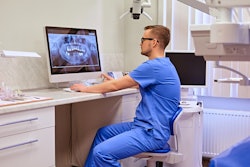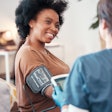A 58-year-old healthy man with stellar oral hygiene and dietary habits developed carious lesions on almost every posterior tooth adjacent to where he habitually held a sugar-free nicotine lozenge. The case report was published in Case Reports in Dentistry.
This case suggests that the frequent use of these lozenges that contain low sugar alcohols like mannitol, as well as sugar-free cough drops and hard candies, that the public assumes are dentally harmless may be associated with dental caries, the authors wrote.
 Maxillary second molar (tooth #2) showing extensive mesial surface root caries. Images courtesy of C Ehrhardt, KK Mäkinen, and CM Cobb. Licensed under a Creative Commons license.
Maxillary second molar (tooth #2) showing extensive mesial surface root caries. Images courtesy of C Ehrhardt, KK Mäkinen, and CM Cobb. Licensed under a Creative Commons license.
"Dental professionals should caution patients (particularly those with xerostomia and root exposure) about potential caries risks associated with sugar-free products," (Case Rep Dent, August 7, 2024), wrote the authors, led by Coral Ehrhardt, a dental hygienist at Moellers & Moellers Family Dentistry in Iowa.
A 58-year-old healthy man
At a routine dental appointment in June 2008, the patient reported quitting smokeless tobacco about six weeks earlier and switched to sugar-free nicotine lozenges. Other than a history of using smokeless tobacco for more than 20 years, the man had no remarkable medical conditions, didn't use prescription or recreational drugs, and abstained from alcohol.
Between 1999 and 2008, he patronized the same dental practice. During that time, he required only two restorations due to caries. His general dentist took vertical bitewing radiographs every 12 to 18 months and a full-mouth radiographic survey was done every three to five years at a periodontal office, according to the report.
At the June 2008 appointment, vertical bitewings showed an area of root caries clinically on the mesial side of a tooth that was repaired two weeks later. The caries were adjacent to one of the spots in which the patient would hold the lozenge in his mouth to dissolve, the authors wrote.
About 19 months later, full-mouth x-rays revealed carious lesions on multiple teeth. Two of his upper jaw molars couldn't be restored and had to be extracted. Another tooth had to be endodontically treated and fixed with a porcelain-fused-to-metal crown, the authors wrote.
 Panoramic radiograph (circa 2016) taken before extractions.
Panoramic radiograph (circa 2016) taken before extractions.
Additionally, x-rays revealed carious lesions on eight other teeth, all of which were restored. However, all were given guarded prognoses due to their sudden, aggressive nature. All restorations placed between December 2009 and March 2010 developed recurring caries, and restorations were replaced or patched at least one time over the next five years, the authors wrote.
 Panoramic radiograph (circa 2016) following extraction of all posterior teeth except the mandibular first bicuspids. Impacted third molars were not removed due to the distinct possibility of ankylosis and the potential for fracturing the posterior wall and floor of the maxillary antrum.
Panoramic radiograph (circa 2016) following extraction of all posterior teeth except the mandibular first bicuspids. Impacted third molars were not removed due to the distinct possibility of ankylosis and the potential for fracturing the posterior wall and floor of the maxillary antrum.
By 2016, it was decided that all but two remaining molars and premolars were extracted. In 2017, the patient had four implants placed and was treatment planned for a shortened dental arch.
 Panoramic radiograph (March 2017) after placement of dental implants and treatment planned for a shortened dental arch.
Panoramic radiograph (March 2017) after placement of dental implants and treatment planned for a shortened dental arch.
Despite these problems, the man continues to use nicotine lozenges, though he has made some changes, including using lozenges that are smaller, dissolve more quickly, and that do not contain maltodextrin (though it contains mannitol). Also, he tries to isolate the lozenge by holding it to his palate with his tongue. Unfortunately, caries remains an issue for several reasons, including that enough dissolved substrate continues to make contact with his teeth by seeping through the edentulous and interproximal areas, the authors wrote.
Important to note
The lozenge this patient used contained maltodextrin, a polysaccharide, and more than 75% mannitol. The U.S. Food and Drug Administration (FDA) considers mannitol a "tooth-friendly" sweetener since it produces less acid when fermented than sucrose. However, the authors believe this assumption may be oversimplified or incorrect. Mannitol and maltodextrin are carbohydrates in nature and under certain conditions can produce acids in the oral environment, the authors wrote.
"This case study calls into question the cariogenic potential of nicotine lozenges containing mannitol and maltodextrin and more broadly questions the dental safety of current FDA standards for labelling these types of sugar-free products," Ehrhardt and colleagues wrote.




















